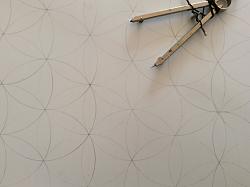I have had quite a lot of practice in compass & straightedge geometry, sacred and profane. I do not think, however, that I have ever completed a construction without making at least one error that requires erasing and emending.
Here’s a case in point ( excuse pun): I want to make a simple display board and have laid out a hexagonal template. All right, the compasses are not best quality, but you may be able to make out at least one spot where the centres of the daisy wheels do not coincide.
Question is: have you ever seen a crop circle with erasures? Many are very complicated: but done in moonlight, and without mistakes!
Is this a can of worms?


 LinkBack URL
LinkBack URL About LinkBacks
About LinkBacks



 Reply With Quote
Reply With Quote


Bookmarks